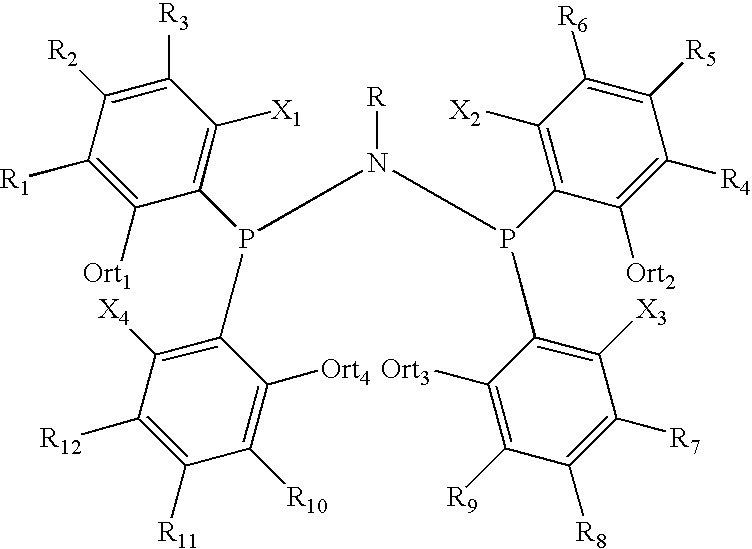Amino phosphine
a technology of amino phosphine and ligand, which is applied in the field of new, can solve the problems of comparatively large amount of internal olefin contamination of ligand, difficult to separate hexene-1 from internal hexenes by distillation, and undesirable contaminants of internal olefins, etc., and achieves the effect of easy determination
- Summary
- Abstract
- Description
- Claims
- Application Information
AI Technical Summary
Benefits of technology
Problems solved by technology
Method used
Image
Examples
example 1
[0085]A 600-mL reactor fitted with a gas-entrained stirrer (1700 rpm) was purged 3 times with argon while heated at 50° C. The reactor was then cooled to 30° C. and a solution of MAO (11.72 g, 10 wt % Al) in 57.31 g of toluene, followed by 86.7 g of toluene was transferred via a stainless steel cannula to the reactor. The reactor was then pressurized with ethylene (15 atmospheres (gauge)) and the temperature adjusted to 45° C. Bis(di-(ortho-fluorophenyl)phosphino)-1-propylamine (33.4 mg, 0.067 mmol) in 8.69 g of toluene was added to chromium acetylacetonate (22.9 mg, 0.066 mmol) in 8.68 g of toluene in a hypovial. The mixture was sonicated at ambient temperature for 1 minute and then transferred under ethylene to the pressurized reactor. Immediately after, additional ethylene was added to increase the reactor pressure to 20 atmospheres (gauge). The reaction was terminated after 12 minutes by stopping the flow of ethylene to the reactor and cooling the contents to 30° C., at which po...
example 2
[0086]A 600 mL reactor fitted with a gas-entrained stirrer (1700 rpm) was purged 3 times with argon while heated at 75° C. The reactor was then cooled to 30° C. and a solution of MAO (11.69 g, 10 wt % Al) in 57.41 g toluene, followed by 86.62 g of toluene was transferred via a stainless steel cannula to the reactor. The reactor was then pressurized with ethylene (15 atmospheres (gauge)) and the temperature adjusted to 70° C. Bis(di-(ortho-fluorophenyl)phosphino)-1-propylamine (33.5 mg, 0.067 mmol) in 8.69 g of toluene was added to chromium acetylacetonate (22.8 mg, 0.065 mmol) in 8.70 g of toluene in a hypovial. The mixture was sonicated at ambient temperature for 1 minute and then transferred under ethylene to the pressurized reactor. Immediately after, additional ethylene was added to increase the reactor pressure to 20 atmospheres (gauge). The reaction was terminated after 21 minutes by stopping the flow of ethylene to the reactor and cooling the contents to 30° C., at which poin...
example 3
[0087]A 600 mL reactor fitted with a gas-entrained stirrer (1700 rpm) was purged 3 times with argon while heated at 50° C. The reactor was then cooled to 30° C. and a solution of MAO (11.70 g, 10 wt % Al) in 57.32 g toluene, followed by 86.7 g of toluene was transferred via a stainless steel cannula to the reactor. The reactor was then pressurized with ethylene (35 atmospheres (gauge)) and the temperature adjusted to 45° C. Bis(di-(ortho-fluorophenyl)phosphino)-1-propylamine (33.5 mg, 0.067 mmol) in 8.70 g of toluene was added to chromium acetylacetonate (22.8 mg, 0.065 mmol) in 8.68 g of toluene in a hypovial. The mixture was sonicated at ambient temperature for 1 minute and then transferred under ethylene to the pressurized reactor. Immediately after, additional ethylene was added to increase the reactor pressure to 40 atmospheres (gauge). The reaction was terminated after 5 minutes by stopping the flow of ethylene to the reactor and cooling the contents to 30° C., at which point ...
PUM
| Property | Measurement | Unit |
|---|---|---|
| Temperature | aaaaa | aaaaa |
| Percent by mass | aaaaa | aaaaa |
| Pressure | aaaaa | aaaaa |
Abstract
Description
Claims
Application Information
 Login to View More
Login to View More - R&D
- Intellectual Property
- Life Sciences
- Materials
- Tech Scout
- Unparalleled Data Quality
- Higher Quality Content
- 60% Fewer Hallucinations
Browse by: Latest US Patents, China's latest patents, Technical Efficacy Thesaurus, Application Domain, Technology Topic, Popular Technical Reports.
© 2025 PatSnap. All rights reserved.Legal|Privacy policy|Modern Slavery Act Transparency Statement|Sitemap|About US| Contact US: help@patsnap.com



